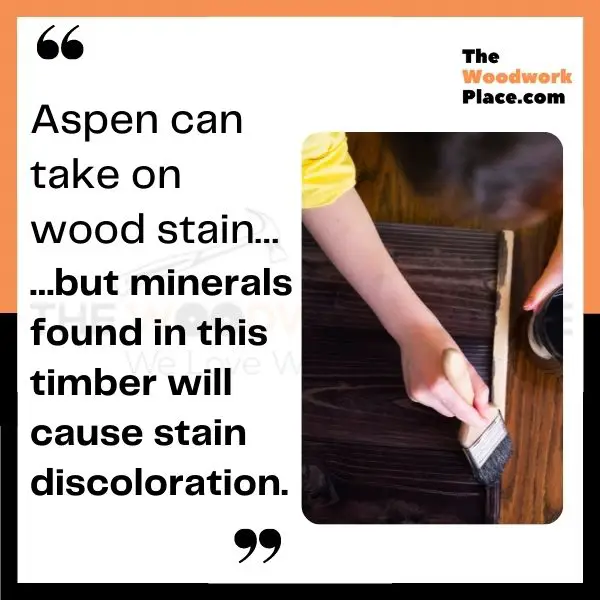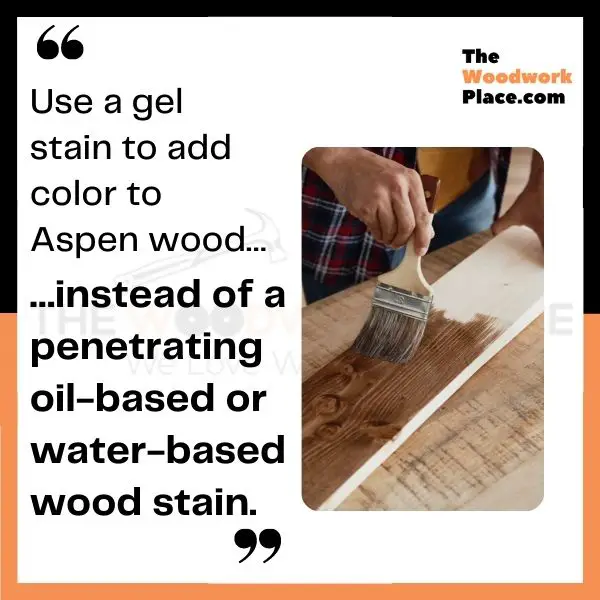Have you ever worked with Aspen wood?
This surprisingly soft hardwood is more affordable that other common domestic lumbers such as Maple, Poplar, and Oak. And its almost knot-free surface makes it incredibly easy to work with.
Yet, Aspen’s pale appearance is a little lacklustre. After all, it’s thanks to that uniform grain that Aspen is often thought of as a paint-grade wood.
Now, paint-grade wood is just that… it’s wood that is only meant to be painted.
That is because paint-graded wood pretty much have plain tight wood grain texture. What’s more, their wood grains texture can make it hard for them to take on any kind of penetrating wood stain. For example, some widely-used paint-grade woods are Poplar, Birch, Pine and Maple.
However, unlike paint grade wood types, Aspen wood can take on penetrating wood finishes very well… but only up to a point.
Staining Aspen wood isn’t your real problem. How that wood stain turns out after you apply it? That is going to be your main issue.
While a wood stain will soak evenly into Aspen wood, wood stain finishes tend to discolor when applied to it. In short, you should not use a penetrating oil-based or water-based wood stain on Aspen.
So, just what is the best way to add more color to that Aspen wood surface?
Below, we will cover why a penetrating stain is not the best choice for Aspen (and why you should use this stain-alternative product instead).
You’ll also discover why Aspen gets compared so often to ‘unstainable’ Poplar Wood (and what that means for your own Aspen woodwork project)…

This post may contain affiliate links to products that we receive a commission for (at no additional cost to you). Learn more here.
Can You Stain Aspen Wood?
Aspen wood doesn’t work great with wood stain, but not for the reason (or in the way) that you might think.
First off, full disclosure, a wood stain will soak evenly into Aspen wood. However, the results you get afterwards don’t look great. Why? Well, it all boils down to Aspen woods composition.
Why Does Wood Composition Effect How Well Aspen Can Take On Stain?
To properly answer that question we need to first cover a little bit of detail regarding Aspens background…
Aspen trees belong to the same tree family as Poplar wood.
Poplar wood, (the kind used for crafts and whittling), belongs to the Populus family tree.
So, underneath the Populus genus, you have ‘Yellow Poplar’ (also known as white poplar). This is the lumber widely used for wood carving and the like.
Related Post: Is Poplar Wood Good For Carving? (Solved!)
In addition to ‘Yellow Poplar’, the Populus tree genus also includes; Balsam Poplar, Cottonwood, and Aspen.
Now, Yellow Poplar wood doesn’t take on stains evenly due to having numerous ‘spongy’ sections all along its grain.
These spongy sections allow wood stain, (and tinted oil finishes), to soak into the grain much too quickly. End result? A blotchy looking finish.
Related Post: This Is Why You Don’t Use Danish Oil On Poplar Wood
However, when it comes to Aspen wood, this lumber bucks the Populus family trend; Aspen wood can actually take on stain. But, Aspen wood contains mineral composites that can discolor wood stain.
In other words, Aspen will soak in wood stain evenly, but it will then go on to change the color of that wood stain. Typically, it will change wood stain color into a greenish brownish, (or a kind of brown-grey color if it is a clear coat).
So, in theory, Aspen can take wood stain. However, in practice, it’s not going to be a nice looking stain finish.

Got It! So Then, What Is The Best Stain For Aspen Wood?
If you want to stain Aspen wood, best practice is to first apply a thin wipe-on poly base coat to seal over the wood grain.
And then after the polyurethane has cured, use a Gel Stain to give that wooden surface your desired color. And simply avoid using a penetrating oil-based wood stain altogether.
Related Post: When Should You Use Tru-oil Vs Wipe-On Poly? [3 Key Comparisons]
You see, gel stains act more like paint, coating onto the surface of wood. They do not need to soak into wood grain to work (like an oil-based or water-based stain).
In addition to that, the polyurethane will act to prevent those aspen mineral composites from discoloring gel stain to boot.

Can You At Least Stain Aspen Plywood Perhaps?
When it comes to plywood, this veneered manufactured wood doesn’t take on stains evenly anyway. No matter what type of hardwood that plywood may be made from.
Related Post: Just What Is Manufactured Wood Anyway?
Which is why, even with Aspen plywood, you should still use a base coat sealer combined with a gel stain.
To Sum Up, Here Are The 3 Main Takeaways:
- 1). Aspen can take on wood stain, but minerals found in this timber will cause stain discoloration.
- 2). Use a Gel Stain instead of a penetrating oil-based or water-based wood stain.
- 3). And remember to seal Aspen with a poly base coat first before you go and coat on any gel stain.
References:
Effect of acetylation on the material properties of glucuronoxylan from aspen wood – ScienceDirect
Separation, characterization and hydrogel-formation of hemicellulose from aspen wood – ScienceDirect
